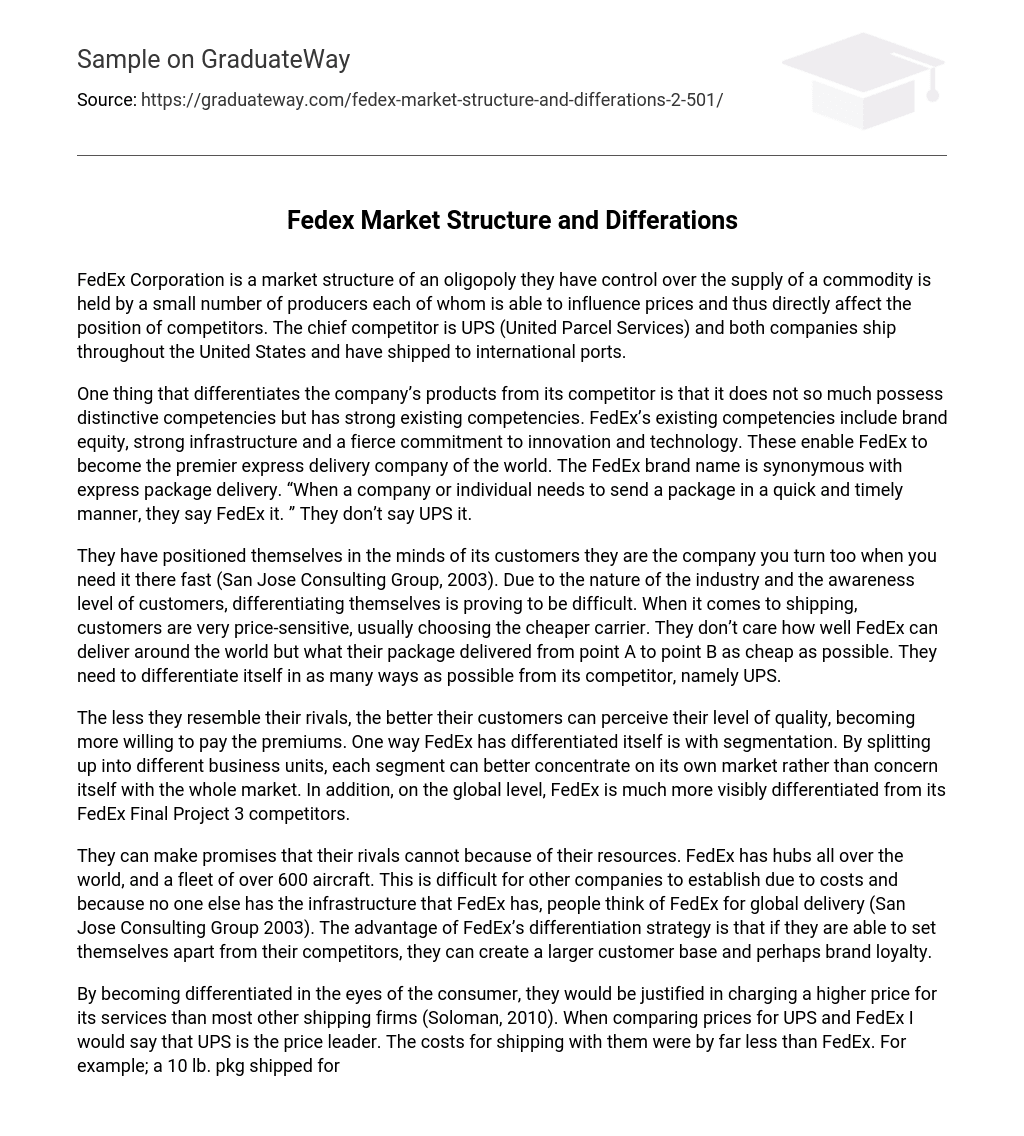FedEx Corporation is a market structure of an oligopoly they have control over the supply of a commodity is held by a small number of producers each of whom is able to influence prices and thus directly affect the position of competitors. The chief competitor is UPS (United Parcel Services) and both companies ship throughout the United States and have shipped to international ports.
One thing that differentiates the company’s products from its competitor is that it does not so much possess distinctive competencies but has strong existing competencies. FedEx’s existing competencies include brand equity, strong infrastructure and a fierce commitment to innovation and technology. These enable FedEx to become the premier express delivery company of the world. The FedEx brand name is synonymous with express package delivery. “When a company or individual needs to send a package in a quick and timely manner, they say FedEx it. ” They don’t say UPS it.
They have positioned themselves in the minds of its customers they are the company you turn too when you need it there fast (San Jose Consulting Group, 2003). Due to the nature of the industry and the awareness level of customers, differentiating themselves is proving to be difficult. When it comes to shipping, customers are very price-sensitive, usually choosing the cheaper carrier. They don’t care how well FedEx can deliver around the world but what their package delivered from point A to point B as cheap as possible. They need to differentiate itself in as many ways as possible from its competitor, namely UPS.
The less they resemble their rivals, the better their customers can perceive their level of quality, becoming more willing to pay the premiums. One way FedEx has differentiated itself is with segmentation. By splitting up into different business units, each segment can better concentrate on its own market rather than concern itself with the whole market. In addition, on the global level, FedEx is much more visibly differentiated from its FedEx Final Project 3 competitors.
They can make promises that their rivals cannot because of their resources. FedEx has hubs all over the world, and a fleet of over 600 aircraft. This is difficult for other companies to establish due to costs and because no one else has the infrastructure that FedEx has, people think of FedEx for global delivery (San Jose Consulting Group 2003). The advantage of FedEx’s differentiation strategy is that if they are able to set themselves apart from their competitors, they can create a larger customer base and perhaps brand loyalty.
By becoming differentiated in the eyes of the consumer, they would be justified in charging a higher price for its services than most other shipping firms (Soloman, 2010). When comparing prices for UPS and FedEx I would say that UPS is the price leader. The costs for shipping with them were by far less than FedEx. For example; a 10 lb. pkg shipped for next day delivery from Ohio to Pennsylvania cost UPS: $59. 00 and FedEx $77. 24. For another same size from Ohio to the zip 15261 cost $40. 87 for FedEx and UPS was $10. 67 and another package shipped overnight across town FedEx cost was $34. 66 and UPS cost $10. 7(Shipping and Tracking 2011).
Company does have a strong marketing budget and is advertised on the television, radio and in the newspapers. The Company has entered Asia and Europe and has been received favorably. FedEx and UPS have different strategic goals and are operating in the same industry but in different main markets. FedEx is working on producing outstanding financial returns and focuses on the overnight air market while UPS is looking for earning a reasonable profit and its core business is the two-day ground delivery. They continue to be strong competitors in the shipping industry.
Reference
- San Jose Consulting Group (2003) FedEx Corporation Strategic Management Project Retrieved November 10, 2011 from www. cob. sjsu. edu/wood_r/lFedExFinal%20Report-rev. doc
- Shipping and Tracking (2011) Tracking and rate simulator Retrieved November 13, 2011 from http://www. shippingandtracking. com/USA/FedEx-UPS/rates_simulator. html
- Solomon, M. (2010) Parcel redux: FedEx follows UPS with bullish forecast retrieved November 12, 2011 from http://www. develocity. com/articles/coloo727fedex_bullish_forecast





